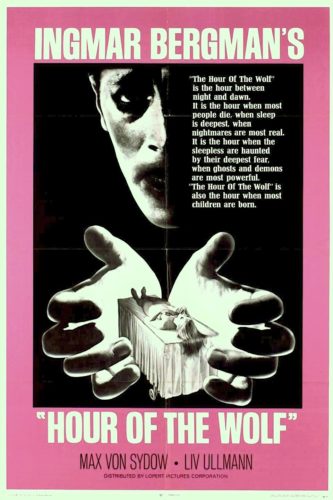 An Ingmar Bergman horror movie! THE HOUR OF THE WOLF was largely dismissed by critics, and truth be told it is quite dumb. Bergman’s unforgettable surrealistic imagery, however, makes this a must-see.
An Ingmar Bergman horror movie! THE HOUR OF THE WOLF was largely dismissed by critics, and truth be told it is quite dumb. Bergman’s unforgettable surrealistic imagery, however, makes this a must-see.
For those who don’t know, the late Ingmar Bergman is the filmmaker who for film buffs most readily springs to mind when the term “art film” is broached. His films—which include the legendary SEVENTH SEAL, CRIES AND WHISPERS, FANNY AND ALEXANDER and many others—were always visually expressive, but often suffocatingly pretentious and horrifically bleak. THE HOUR OF THE WOLF (VARGTIMMEN) was made in 1968, in between PERSONA (1966) and SHAME (1968), two of Bergman’s most acclaimed films. In fact, HOUR OF THE WOLF’S underlying themes were initially conceived as part of PERSONA, but Bergman eventually removed them for inclusion in this film.
It stars Max Von Sydow and Liv Ullmann, Bergman’s most frequent and recognizable cast members (Ullmann was pregnant with Bergman’s child during filming). Also on hand was the filmmaker’s stock cinematographer Sven Nykvist, who’s arguably as responsible for the distinctness of Ingmar Bergman’s films as the filmmaker himself.
Alma is married to Johan Borg, a famous artist. Through entries in Johan’s diary and Alma’s testimony, the story of Johan’s final days is pieced together.
The two left their home for a secluded island, presumably to avert a nervous breakdown in the increasingly on-edge Johan. But his demons followed him to the island—literally. A woman claiming to be over 200 years old approaches Anna one day and exhorts her to read Johan’s private journal. Alma does so, and, much to her understandable displeasure, comes upon a passage describing a torrid affair Johann had years earlier. All the while Johan stays up each night. He’s afraid of the Hour of the Wolf (3 AM), the time when the most people die and the most children are born, and when ghosts and demons are at their most powerful.
One day Johan and Alma are invited to a party thrown by a bunch of rich people living on the island, but the get-together is a smarmy affair that only intensifies Johan’s inner torment. That night all Hell breaks loose: Johan is moved to reveal to Alma that he once murdered a young boy—he then shoots her, or thinks he does, and enters into an increasingly surreal universe where a man walks upside-down, a woman rips off her face and another woman’s corpse springs to lascivious life. Eventually Johan is pecked to death by the previous evening’s party guests, who’ve turned into giant predatory birds.
This leaves Alma, who in the final scenes reveals that she witnessed the climactic attack, after which her husband and his tormentors all vanished. It seems she’s become infected with Johan’s madness.
Ingmar Bergman’s filmmaking hails from a different era than our own. He didn’t rely on multiple set-ups or editing to advance his story, but on old-fashioned craftsmanship. This means HOUR OF THE WOLF is visualized through a series of carefully chosen wide shots and a minimum of close-ups.
Contrary to what many commentators would have you believe, this is very much a horror film in the atmosphere of tense expectancy that gives way to all-out insanity in the final third. This section is a dazzling flow of horrific strangeness, one of Bergman’s few forays into special effects filmmaking, enhanced immeasurably by Sven Nykvist’s incredibly evocative black and white photography.
Of course content-wise the film isn’t much. It’s trite and simplistic, and Johan and Alma are both painfully underdeveloped characters. It’s never made clear where Johan’s delusions come from, nor why the seemingly sane and level-headed Alma stays with him.
An intriguing angle is broached in the final scenes, in which it seems Alma might be becoming infected with Johan’s insanity (making this film something of a precursor to William Friedkin’s BUG). I wish Bergman had done more with this idea, as the framing device—of Johan’s journal entries filtered through Alma’s recollections—would seem to allow for an interplay of illusion and reality far more complex than what Bergman has provided (for the record, he later admitted that HOUR OF THE WOLF’S narrative isn’t all it could be).
But I recommend HOUR OF THE WOLF for its stunning visuals. As a surreal spectacle the film is virtually unmatched, even if in every other respect it has indeed been matched, and bettered, many times over.
Vital Statistics
HOUR OF THE WOLF (VARGTIMMEN)
Svensk Filmindustri
Director: Ingmar Bergman
Producer: Lars-Owe Carlberg
Screenplay: Ingmar Bergman
Cinematography: Sven Nykvist
Editing: Ulla Ryghe
Cast: Max Von Sydow, Liv Ullmann, Gertrud Fridh, Georg Rydeberg, Erland Josephson, Naima Wifstrand, Ulf Johansson, Gundrun Brost, Bertil Anderberg, Ingrid Thulin
